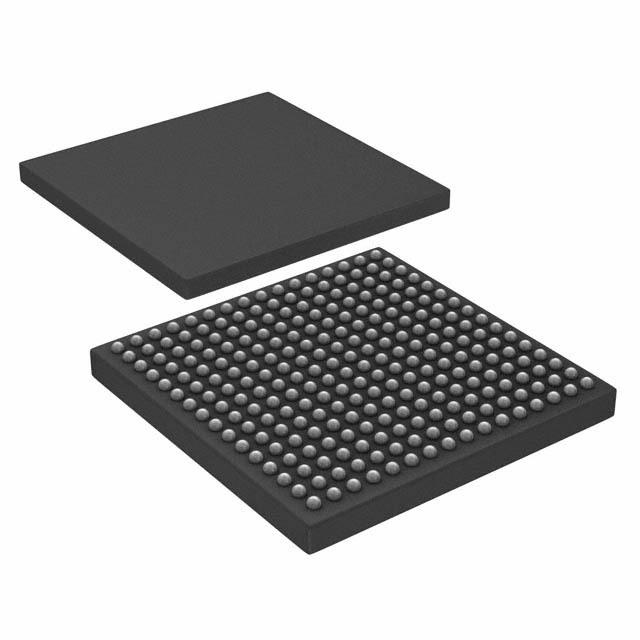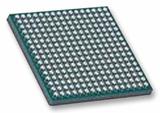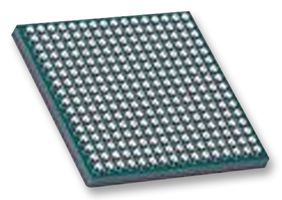



32Bit ARM Cortex-M3 flashless MCU with security features; 200KB SRAM; Ethernet, two HS USB, LCD, EMC
Overview
The LPC18S50FET256 is a ARM Cortex-M3 based microcontroller with security features for embedded applications. The ARM Cortex-M3 is a next generation core that offers system enhancements such as low power consumption, enhanced debug features, and a high level of support block integration.
The LPC18S50FET256 operates at CPU frequencies of up to 180 MHz. The ARM Cortex-M3 CPU incorporates a 3-stage pipeline and uses a Harvard architecture with separate local instruction and data buses as well as a third bus for peripherals. The ARM Cortex-M3 CPU also includes an internal prefetch unit that supports speculative branching.
The LPC18S50FET256 includes 200 kB of on-chip SRAM, security features with AES engine, a quad SPI Flash Interface SPIFI, a State Configurable Timer/PWM SCTimer/PWM subsystem, two High-speed USB controllers, Ethernet, LCD, an external memory controller, and multiple digital and analog peripherals.
MoreLess
## Features
* Processor core
* ARM Cortex-M3 processor, running at frequencies of up to 180 MHz.
* ARM Cortex-M3 built-in Memory Protection Unit MPU supporting eight regions.
* ARM Cortex-M3 built-in Nested Vectored Interrupt Controller NVIC.
* Non-maskable Interrupt NMI input.
* JTAG and Serial Wire Debug, serial trace, eight breakpoints, and four watch points.
* Enhanced Trace Module ETM and Enhanced Trace Buffer ETB support.
* System tick timer.
* On-chip memory
* 200 kB SRAM for code and data use.
* Multiple SRAM blocks with separate bus access.
* 64 kB ROM containing boot code and on-chip software drivers.
* 64 bit One-Time Programmable OTP memory for general-purpose use.
* Two banks 256 bit total One-Time Programmable OTP memory for AES key storage One bank can store an encrypted key for decoding the boot image.
* AES engine for encryption and decryption of the boot image and data with DMA support and programmable via a ROM-based API.
* Clock generation unit
* Crystal oscillator with an operating range of 1 MHz to 25 MHz.
* 12 MHz internal RC oscillator trimmed to 1.5 % accuracy over temperature and voltage.
* Ultra-low power RTC crystal oscillator.
* Three PLLs allow CPU operation up to the maximum CPU rate without the need for a high-frequency crystal. The second PLL is dedicated to the High-speed USB, the third PLL can be used as audio PLL.
* Clock output.
* Configurable digital peripherals:
* State Configurable Timer SCTimer/PWM subsystem on AHB.
* Global Input Multiplexer Array GIMA allows to cross-connect multiple inputs and outputs to event driven peripherals like timers, SCTimer/PWM, and ADC0/1.
* Serial interfaces
* Quad SPI Flash Interface SPIFI with 1-, 2-, or 4-bit data at rates of up to 52 MB per second.
* 10/100T Ethernet MAC with RMII and MII interfaces and DMA support for high throughput at low CPU load. Support for IEEE 1588 time stamping/advanced time stamping IEEE 1588-2008 v2.
* One High-speed USB 2.0 Host/Device/OTG interface with DMA support and on-chip high-speed PHY USB0.
* One High-speed USB 2.0 Host/Device interface with DMA support, on-chip full-speed PHY and ULPI interface to an external high-speed PHY USB1.
* USB interface electrical test software included in ROM USB stack.
* Four 550 UARTs with DMA support: one UART with full modem interface; one UART with IrDA interface; three USARTs support UART synchronous mode and a smart card interface conforming to ISO7816 specification.
* Up to two C_CAN 2.0B controllers with one channel each. Use of C_CAN controller excludes operation of all other peripherals connected to the same bus bridge.
* Two SSP controllers with FIFO and multi-protocol support. Both SSPs with DMA support.
* One Fast-mode Plus I2C-bus interface with monitor mode and with open-drain I/O pins conforming to the full I2C-bus specification. Supports data rates of up to 1 Mbit/s.
* One standard I²C-bus interface with monitor mode and standard I/O pins.
* Two I²S interfaces with DMA support, each with one input and one output.
* Digital peripherals
* External Memory Controller EMC supporting external SRAM, ROM, NOR flash, and SDRAM devices.
* LCD controller with DMA support and a programmable display resolution of up to 1024 H x 768 V. Supports monochrome and color STN panels and TFT color panels; supports 1/2/4/8 bpp Color Look-Up Table CLUT and 16/24-bit direct pixel mapping.
* Secure Digital Input Output SD/MMC card interface.
* Eight-channel General-Purpose DMA controller can access all memories on the AHB and all DMA-capable AHB slaves.
* Up to 164 General-Purpose Input/Output GPIO pins with configurable pull-up/pull-down resistors.
* GPIO registers are located on the AHB for fast access. GPIO ports have DMA support.
* Up to eight GPIO pins can be selected from all GPIO pins as edge and level sensitive interrupt sources.
* Two GPIO group interrupt modules enable an interrupt based on a programmable pattern of input states of a group of GPIO pins.
* Four general-purpose timer/counters with capture and match capabilities.
* One motor control PWM for three-phase motor control.
* One Quadrature Encoder Interface QEI.
* Repetitive Interrupt timer RI timer.
* Windowed watchdog timer.
* Ultra-low power Real-Time Clock RTC on separate power domain with 256 bytes of battery powered backup registers.
* Alarm timer; can be battery powered.
* Analog peripherals
* One 10-bit DAC with DMA support and a data conversion rate of 400 kSamples/s.
* Two 10-bit ADCs with DMA support and a data conversion rate of 400 kSamples/s. Up to eight input channels per ADC.
* Unique ID for each device.
* Power
* Single 3.3 V 2.2 V to 3.6 V power supply with on-chip internal voltage regulator for the core supply and the RTC power domain.
* RTC power domain can be powered separately by a 3 V battery supply.
* Four reduced power modes: Sleep, Deep-sleep, Power-down, and Deep power-down.
* Processor wake-up from Sleep mode via wake-up interrupts from various peripherals.
* Wake-up from Deep-sleep, Power-down, and Deep power-down modes via external interrupts and interrupts generated by battery powered blocks in the RTC power domain.
* Brownout detect with four separate thresholds for interrupt and forced reset.
* Power-On Reset POR.
* Available as 144-pin LQFP packages and as 256-pin, 180-pin, and 100-pin BGA packages.
## Target Applications
* Communication hubs
* Automotive aftermarket
* Power management
* Consumer health devices
* Embedded audio applications
* Industrial control
* Industrial automation
* White goods
## Features
电源电压DC 2.20V min
针脚数 256
时钟频率 180 MHz
RAM大小 200 KB
位数 32
模数转换数ADC 2
输入/输出数 164 Input
工作温度Max 125 ℃
耗散功率Max 1500 mW
数模转换数DAC 1
电源电压 2.2V ~ 3.6V
电源电压Max 3.6 V
电源电压Min 2.2 V
引脚数 256
封装 LBGA-256
封装 LBGA-256
工作温度 -40℃ ~ 85℃ TA
产品生命周期 Pre-Release
包装方式 Tray
RoHS标准 RoHS Compliant
含铅标准 Lead Free
REACH SVHC版本 2015/12/17